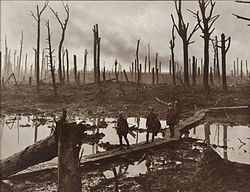Duckboards
Duckboards are wooden walkways. They are usually put over muddy ground. Doing this means that people can walk on the dry duckboards instead of the muddy ground.
Hiking
Duckboards are used to allow hikers to walk over wet and/or muddy ground, like a swamp or shores of a lake. Very wide duckboards are used sometimes so that wheelchair users can use them. Duckboards can be nailed into logs with wooden stakes.
World War I
During World War I, duckboards were put along the ground of trenches on the Western Front. This is because the trenches usually flooded. Mud and water would stay in the trenches for months. The boards helped to keep the soldiers' feet dry. It also helped stop soldiers get a disease called trench foot. Trench foot is caused by standing on wet, muddy ground for a long time. They also helped soldiers move along the trenches faster. Sometimes, falling from duckboards could be deadly. Some unlucky soldiers drowned in mud because of their heavy equipment.
Duckboards Media
Atlantic City, New Jersey boardwalk, as seen from Caesars Atlantic City, opened in 1870, as the first U.S. boardwalk. At 5+1⁄2 miles (9 km) long, it is also one of the world's longest, busiest, and oldest boardwalks. New Jersey is home to the world's highest concentration of boardwalks.
A typical nature boardwalk, carrying walkers over wetlands on the Milford Track, New Zealand
Australian soldiers walking along duckboards during the Battle of Passchendaele
A wooden boardwalk allows passage through a lake, such as this one in Plitvice Lakes National Park, Croatia.
This boardwalk allows people to cross Horicon Marsh.
Boardwalks help walkers navigate difficult terrain as at Pyhä-Luosto National Park in Lapland, Finland.
Duckboards on the Lake Storträsk at Sipoonkorpi National Park in Uusimaa, Finland.
A duckboard enables those on foot to cross a bog in Estonia.
Boardwalk at Ocmulgee National Monument
Other websites
![]() Media related to Duckboards at Wikimedia Commons
Media related to Duckboards at Wikimedia Commons









